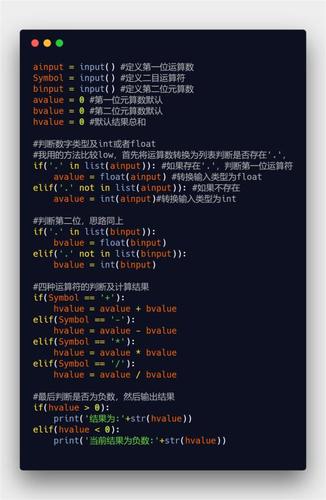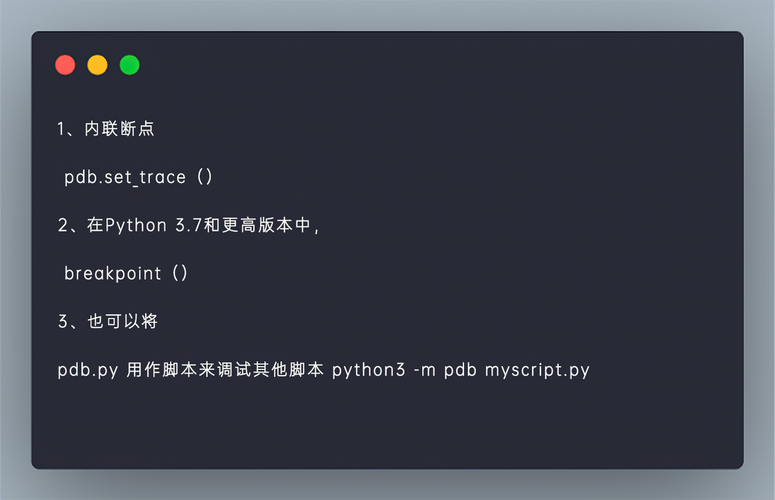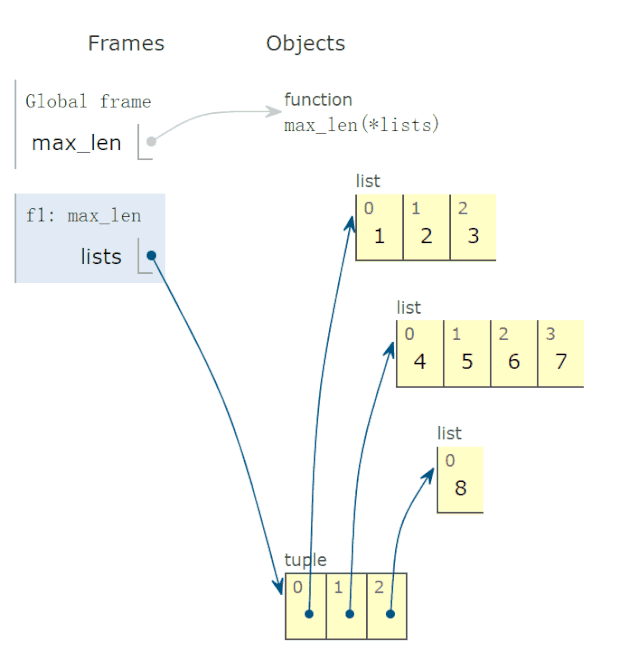- 1有关java.lang.ArrayStoreException运行异常的解决方法_java.lang.arraystoreexception: java.lang.long
- 2STM32CubeMX & Keil——STM32F103C8T6:PWM控制LED灯_stm32pwmled灯
- 3YOLOv8+DeepSort/ByteTrack-PyQt-GUI / yolov5 deepsort 行人/车辆(检测 +计数+跟踪+测距+测速)_基于yolov8与bytetrack的车辆检测追踪与流量计数系统【python源码+pyqt5界面+
- 4JDK1.6新特性
- 5androidstdio生成的apk在某些手机上运行闪退
- 6【Python】系列之面向对象编程_python面向对象编程
- 7【论文阅读】 Forging Vision Foundation Models for Autonomous Driving: Challenges, Methodologies, and..._目前都有哪些foundation model vision
- 8基于python的电影爬虫可视化系统设计与实现_python爬虫爬取电影文献综述
- 9vue报错:in ../node_modules/axios/lib/platform/index.js_vue报错axios
- 10STM32CubeMX配置定时器输入捕获功能_stm32 输入捕获 cubemx
python编程100个小程序,python简单的小程序_python小程序源代码
赞
踩
本篇文章给大家谈谈python编程100个小程序,以及python简单的小程序,希望对各位有所帮助,不要忘了收藏本站喔。

本篇文章给大家谈谈python简单有趣的程序源代码,以及简单的python有趣小程序,希望对各位有所帮助,不要忘了收藏本站喔。

小例子
一、 数字
1 求绝对值
绝对值或复数的模
- In [1]: abs(-6)
- Out[1]: 6
2 进制转化
- In [2]: bin(10)
- Out[2]: '0b1010'
十进制转换为八进制:
- In [3]: oct(9)
- Out[3]: '0o11'
十进制转换为十六进制:
- In [4]: hex(15)
- Out[4]: '0xf'
3 整数和ASCII互转
十进制整数对应的ASCII字符
- In [1]: chr(65)
- Out[1]: 'A'
查看某个ASCII字符对应的十进制数
- In [1]: ord('A')
- Out[1]: 65
4 元素都为真检查
所有元素都为真,返回 True,否则为False
- In [5]: all([1,0,3,6])
- Out[5]: False
- In [6]: all([1,2,3])
- Out[6]: True
5 元素至少一个为真检查
至少有一个元素为真返回True,否则False
- In [7]: any([0,0,0,[]])
- Out[7]: False
- In [8]: any([0,0,1])
- Out[8]: True
6 判断是真是假
测试一个对象是True, 还是False.
- In [9]: bool([0,0,0])
- Out[9]: True
-
- In [10]: bool([])
- Out[10]: False
-
- In [11]: bool([1,0,1])
- Out[11]: True
7 创建复数
创建一个复数
- In [1]: complex(1,2)
- Out[1]: (1+2j)
8 取商和余数
分别取商和余数
- In [1]: divmod(10,3)
- Out[1]: (3, 1)
9 转为浮点类型
将一个整数或数值型字符串转换为浮点数
- In [1]: float(3)
- Out[1]: 3.0
如果不能转化为浮点数,则会报ValueError:
- In [2]: float('a')
- # ValueError: could not convert string to float: 'a'
10 转为整型
int(x, base =10) , x可能为字符串或数值,将x 转换为一个普通整数python流星雨特效代码简单。如果参数是字符串,那么它可能包含符号和小数点用python绘制满天星100颗。如果超出了普通整数的表示范围,一个长整数被返回。
- In [1]: int('12',16)
- Out[1]: 18
11 次幂
base为底的exp次幂,如果mod给出,取余
- In [1]: pow(3, 2, 4)
- Out[1]: 1
12 四舍五入
四舍五入,ndigits代表小数点后保留几位:
- In [11]: round(10.0222222, 3)
- Out[11]: 10.022
-
- In [12]: round(10.05,1)
- Out[12]: 10.1
13 链式比较
- i = 3
- print(1 < i < 3) # False
- print(1 < i <= 3) # True
二、 字符串
14 字符串转字节
字符串转换为字节类型
- In [12]: s = "apple"
-
- In [13]: bytes(s,encoding='utf-8')
- Out[13]: b'apple'
15 任意对象转为字符串
- In [14]: i = 100
-
- In [15]: str(i)
- Out[15]: '100'
-
- In [16]: str([])
- Out[16]: '[]'
-
- In [17]: str(tuple())
- Out[17]: '()'
16 执行字符串表示的代码
将字符串编译成python能识别或可执行的代码,也可以将文字读成字符串再编译。
- In [1]: s = "print('helloworld')"
-
- In [2]: r = compile(s,"<string>", "exec")
-
- In [3]: r
- Out[3]: <code object <module> at 0x0000000005DE75D0, file "<string>", line 1>
-
- In [4]: exec(r)
- helloworld
17 计算表达式
将字符串str 当成有效的表达式来求值并返回计算结果取出字符串中内容
- In [1]: s = "1 + 3 +5"
- ...: eval(s)
- ...:
- Out[1]: 9
18 字符串格式化
格式化输出字符串,format(value, format_spec)实质上是调用了value的__format__(format_spec)方法。
- In [104]: print("i am {0},age{1}".format("tom",18))
- i am tom,age18
| 3.1415926 | {:.2f} | 3.14 | 保留小数点后两位 |
|---|---|---|---|
| 3.1415926 | {:+.2f} | +3.14 | 带符号保留小数点后两位 |
| -1 | {:+.2f} | -1.00 | 带符号保留小数点后两位 |
| 2.71828 | {:.0f} | 3 | 不带小数 |
| 5 | {:0>2d} | 05 | 数字补零 (填充左边, 宽度为2) |
| 5 | {:x<4d} | 5xxx | 数字补x (填充右边, 宽度为4) |
| 10 | {:x<4d} | 10xx | 数字补x (填充右边, 宽度为4) |
| 1000000 | {:,} | 1,000,000 | 以逗号分隔的数字格式 |
| 0.25 | {:.2%} | 25.00% | 百分比格式 |
| 1000000000 | {:.2e} | 1.00e+09 | 指数记法 |
| 18 | {:>10d} | ' 18' | 右对齐 (默认, 宽度为10) |
| 18 | {:<10d} | '18 ' | 左对齐 (宽度为10) |
| 18 | {:^10d} | ' 18 ' | 中间对齐 (宽度为10) |
三、 函数
19 拿来就用的排序函数
排序:
- In [1]: a = [1,4,2,3,1]
-
- In [2]: sorted(a,reverse=True)
- Out[2]: [4, 3, 2, 1, 1]
-
- In [3]: a = [{'name':'xiaoming','age':18,'gender':'male'},{'name':'
- ...: xiaohong','age':20,'gender':'female'}]
- In [4]: sorted(a,key=lambda x: x['age'],reverse=False)
- Out[4]:
- [{'name': 'xiaoming', 'age': 18, 'gender': 'male'},
- {'name': 'xiaohong', 'age': 20, 'gender': 'female'}]
20 求和函数
求和:
- In [181]: a = [1,4,2,3,1]
-
- In [182]: sum(a)
- Out[182]: 11
-
- In [185]: sum(a,10) #求和的初始值为10
- Out[185]: 21
21 nonlocal用于内嵌函数中
关键词nonlocal常用于函数嵌套中,声明变量i为非局部变量;如果不声明,i+=1表明i为函数wrapper内的局部变量,因为在i+=1引用(reference)时,i未被声明,所以会报unreferenced variable的错误。
- def excepter(f):
- i = 0
- t1 = time.time()
- def wrapper():
- try:
- f()
- except Exception as e:
- nonlocal i
- i += 1
- print(f'{e.args[0]}: {i}')
- t2 = time.time()
- if i == n:
- print(f'spending time:{round(t2-t1,2)}')
- return wrapper
22 global 声明全局变量
先回答为什么要有global,一个变量被多个函数引用,想让全局变量被所有函数共享。有的伙伴可能会想这还不简单,这样写:
- i = 5
- def f():
- print(i)
-
- def g():
- print(i)
- pass
-
- f()
- g()
f和g两个函数都能共享变量i,程序没有报错,所以他们依然不明白为什么要用global.
但是,如果我想要有个函数对i递增,这样:
- def h():
- i += 1
-
- h()
此时执行程序,bang, 出错了!抛出异常:UnboundLocalError,原来编译器在解释i+=1时会把i解析为函数h()内的局部变量,很显然在此函数内,编译器找不到对变量i的定义,所以会报错。
global就是为解决此问题而被提出,在函数h内,显式地告诉编译器i为全局变量,然后编译器会在函数外面寻找i的定义,执行完i+=1后,i还为全局变量,值加1:
- i = 0
- def h():
- global i
- i += 1
-
- h()
- print(i)
23 交换两元素
- def swap(a, b):
- return b, a
-
-
- print(swap(1, 0)) # (0,1)
24 操作函数对象
- In [31]: def f():
- ...: print('i\'m f')
- ...:
-
- In [32]: def g():
- ...: print('i\'m g')
- ...:
-
- In [33]: [f,g][1]()
- i'm g
创建函数对象的list,根据想要调用的index,方便统一调用。
25 生成逆序序列
list(range(10,-1,-1)) # [10, 9, 8, 7, 6, 5, 4, 3, 2, 1, 0]第三个参数为负时,表示从第一个参数开始递减,终止到第二个参数(不包括此边界)
26 函数的五类参数使用例子
python五类参数:位置参数,关键字参数,默认参数,可变位置或关键字参数的使用。
- def f(a,*b,c=10,**d):
- print(f'a:{a},b:{b},c:{c},d:{d}')
默认参数c不能位于可变关键字参数d后.
调用f:
- In [10]: f(1,2,5,width=10,height=20)
- a:1,b:(2, 5),c:10,d:{'width': 10, 'height': 20}
可变位置参数b实参后被解析为元组(2,5);而c取得默认值10; d被解析为字典.
再次调用f:
- In [11]: f(a=1,c=12)
- a:1,b:(),c:12,d:{}
a=1传入时a就是关键字参数,b,d都未传值,c被传入12,而非默认值。
注意观察参数a, 既可以f(1),也可以f(a=1) 其可读性比第一种更好,建议使用f(a=1)。如果要强制使用f(a=1),需要在前面添加一个星号:
- def f(*,a,**b):
- print(f'a:{a},b:{b}')
此时f(1)调用,将会报错:TypeError: f() takes 0 positional arguments but 1 was given
只能f(a=1)才能OK.
说明前面的*发挥作用,它变为只能传入关键字参数,那么如何查看这个参数的类型呢?借助python的inspect模块:
- In [22]: for name,val in signature(f).parameters.items():
- ...: print(name,val.kind)
- ...:
- a KEYWORD_ONLY
- b VAR_KEYWORD
可看到参数a的类型为KEYWORD_ONLY,也就是仅仅为关键字参数。
但是,如果f定义为:
- def f(a,*b):
- print(f'a:{a},b:{b}')
查看参数类型:
- In [24]: for name,val in signature(f).parameters.items():
- ...: print(name,val.kind)
- ...:
- a POSITIONAL_OR_KEYWORD
- b VAR_POSITIONAL
可以看到参数a既可以是位置参数也可是关键字参数。
27 使用slice对象
生成关于蛋糕的序列cake1:
- In [1]: cake1 = list(range(5,0,-1))
-
- In [2]: b = cake1[1:10:2]
-
- In [3]: b
- Out[3]: [4, 2]
-
- In [4]: cake1
- Out[4]: [5, 4, 3, 2, 1]
再生成一个序列:
- In [5]: from random import randint
- ...: cake2 = [randint(1,100) for _ in range(100)]
- ...: # 同样以间隔为2切前10个元素,得到切片d
- ...: d = cake2[1:10:2]
- In [6]: d
- Out[6]: [75, 33, 63, 93, 15]
你看,我们使用同一种切法,分别切开两个蛋糕cake1,cake2. 后来发现这种切法极为经典,又拿它去切更多的容器对象。
那么,为什么不把这种切法封装为一个对象呢?于是就有了slice对象。
定义slice对象极为简单,如把上面的切法定义成slice对象:
- perfect_cake_slice_way = slice(1,10,2)
- #去切cake1
- cake1_slice = cake1[perfect_cake_slice_way]
- cake2_slice = cake2[perfect_cake_slice_way]
-
- In [11]: cake1_slice
- Out[11]: [4, 2]
-
- In [12]: cake2_slice
- Out[12]: [75, 33, 63, 93, 15]
与上面的结果一致。
对于逆向序列切片,slice对象一样可行:
- a = [1,3,5,7,9,0,3,5,7]
- a_ = a[5:1:-1]
-
- named_slice = slice(5,1,-1)
- a_slice = a[named_slice]
-
- In [14]: a_
- Out[14]: [0, 9, 7, 5]
-
- In [15]: a_slice
- Out[15]: [0, 9, 7, 5]
频繁使用同一切片的操作可使用slice对象抽出来,复用的同时还能提高代码可读性。
28 lambda 函数的动画演示
有些读者反映,lambda函数不太会用,问我能不能解释一下。
比如,下面求这个 lambda函数:
- def max_len(*lists):
- return max(*lists, key=lambda v: len(v))
有两点疑惑:
-
参数
v的取值? -
lambda函数有返回值吗?如果有,返回值是多少?
调用上面函数,求出以下三个最长的列表:
- r = max_len([1, 2, 3], [4, 5, 6, 7], [8])
- print(f'更长的列表是{r}')
程序完整运行过程,动画演示如下:

结论:
-
参数v的可能取值为
*lists,也就是tuple的一个元素。 -
lambda函数返回值,等于lambda v冒号后表达式的返回值。
四、 数据结构
29 转为字典
创建数据字典
- In [1]: dict()
- Out[1]: {}
-
- In [2]: dict(a='a',b='b')
- Out[2]: {'a': 'a', 'b': 'b'}
-
- In [3]: dict(zip(['a','b'],[1,2]))
- Out[3]: {'a': 1, 'b': 2}
-
- In [4]: dict([('a',1),('b',2)])
- Out[4]: {'a': 1, 'b': 2}
30 冻结集合
创建一个不可修改的集合。
- In [1]: frozenset([1,1,3,2,3])
- Out[1]: frozenset({1, 2, 3})
因为不可修改,所以没有像set那样的add和pop方法
31 转为集合类型
返回一个set对象,集合内不允许有重复元素:
- In [159]: a = [1,4,2,3,1]
-
- In [160]: set(a)
- Out[160]: {1, 2, 3, 4}
32 转为切片对象
class slice(start, stop[, step])
返回一个表示由 range(start, stop, step) 所指定索引集的 slice对象,它让代码可读性、可维护性变好。
- In [1]: a = [1,4,2,3,1]
-
- In [2]: my_slice_meaning = slice(0,5,2)
-
- In [3]: a[my_slice_meaning]
- Out[3]: [1, 2, 1]
33 转元组
tuple() 将对象转为一个不可变的序列类型
- In [16]: i_am_list = [1,3,5]
- In [17]: i_am_tuple = tuple(i_am_list)
- In [18]: i_am_tuple
- Out[18]: (1, 3, 5)
五、 类和对象
34 是否可调用
检查对象是否可被调用
- In [1]: callable(str)
- Out[1]: True
-
- In [2]: callable(int)
- Out[2]: True
- In [18]: class Student():
- ...: def __init__(self,id,name):
- ...: self.id = id
- ...: self.name = name
- ...: def __repr__(self):
- ...: return 'id = '+self.id +', name = '+self.name
- ...
-
- In [19]: xiaoming = Student('001','xiaoming')
-
- In [20]: callable(xiaoming)
- Out[20]: False
如果能调用xiaoming(), 需要重写Student类的__call__方法:
- In [1]: class Student():
- ...: def __init__(self,id,name):
- ...: self.id = id
- ...: self.name = name
- ...: def __repr__(self):
- ...: return 'id = '+self.id +', name = '+self.name
- ...: def __call__(self):
- ...: print('I can be called')
- ...: print(f'my name is {self.name}')
- ...:
-
- In [2]: t = Student('001','xiaoming')
-
- In [3]: t()
- I can be called
- my name is xiaoming

35 ascii 展示对象
调用对象的 __repr__ 方法,获得该方法的返回值,如下例子返回值为字符串
- >>> class Student():
- def __init__(self,id,name):
- self.id = id
- self.name = name
- def __repr__(self):
- return 'id = '+self.id +', name = '+self.name
调用:
- >>> xiaoming = Student(id='1',name='xiaoming')
- >>> xiaoming
- id = 1, name = xiaoming
- >>> ascii(xiaoming)
- 'id = 1, name = xiaoming'
36 类方法
classmethod 装饰器对应的函数不需要实例化,不需要 self 参数,但第一个参数需要是表示自身类的 cls 参数,可以来调用类的属性,类的方法,实例化对象等。
- In [1]: class Student():
- ...: def __init__(self,id,name):
- ...: self.id = id
- ...: self.name = name
- ...: def __repr__(self):
- ...: return 'id = '+self.id +', name = '+self.name
- ...: @classmethod
- ...: def f(cls):
- ...: print(cls)
37 动态删除属性
删除对象的属性
- In [1]: delattr(xiaoming,'id')
-
- In [2]: hasattr(xiaoming,'id')
- Out[2]: False
38 一键查看对象所有方法
不带参数时返回当前范围内的变量、方法和定义的类型列表;带参数时返回参数的属性,方法列表。
- In [96]: dir(xiaoming)
- Out[96]:
- ['__class__',
- '__delattr__',
- '__dict__',
- '__dir__',
- '__doc__',
- '__eq__',
- '__format__',
- '__ge__',
- '__getattribute__',
- '__gt__',
- '__hash__',
- '__init__',
- '__init_subclass__',
- '__le__',
- '__lt__',
- '__module__',
- '__ne__',
- '__new__',
- '__reduce__',
- '__reduce_ex__',
- '__repr__',
- '__setattr__',
- '__sizeof__',
- '__str__',
- '__subclasshook__',
- '__weakref__',
-
- 'name']

39 动态获取对象属性
获取对象的属性
- In [1]: class Student():
- ...: def __init__(self,id,name):
- ...: self.id = id
- ...: self.name = name
- ...: def __repr__(self):
- ...: return 'id = '+self.id +', name = '+self.name
-
- In [2]: xiaoming = Student(id='001',name='xiaoming')
- In [3]: getattr(xiaoming,'name') # 获取xiaoming这个实例的name属性值
- Out[3]: 'xiaoming'
40 对象是否有这个属性
- In [1]: class Student():
- ...: def __init__(self,id,name):
- ...: self.id = id
- ...: self.name = name
- ...: def __repr__(self):
- ...: return 'id = '+self.id +', name = '+self.name
-
- In [2]: xiaoming = Student(id='001',name='xiaoming')
- In [3]: hasattr(xiaoming,'name')
- Out[3]: True
-
- In [4]: hasattr(xiaoming,'address')
- Out[4]: False
41 对象门牌号
返回对象的内存地址
- In [1]: id(xiaoming)
- Out[1]: 98234208
42 isinstance
判断object是否为类classinfo的实例,是返回true
- In [1]: class Student():
- ...: def __init__(self,id,name):
- ...: self.id = id
- ...: self.name = name
- ...: def __repr__(self):
- ...: return 'id = '+self.id +', name = '+self.name
-
- In [2]: xiaoming = Student(id='001',name='xiaoming')
-
- In [3]: isinstance(xiaoming,Student)
- Out[3]: True
43 父子关系鉴定
- In [1]: class undergraduate(Student):
- ...: def studyClass(self):
- ...: pass
- ...: def attendActivity(self):
- ...: pass
-
- In [2]: issubclass(undergraduate,Student)
- Out[2]: True
-
- In [3]: issubclass(object,Student)
- Out[3]: False
-
- In [4]: issubclass(Student,object)
- Out[4]: True
如果class是classinfo元组中某个元素的子类,也会返回True
- In [1]: issubclass(int,(int,float))
- Out[1]: True
44 所有对象之根
object 是所有类的基类
- In [1]: o = object()
-
- In [2]: type(o)
- Out[2]: object
45 创建属性的两种方式
返回 property 属性,典型的用法:
- class C:
- def __init__(self):
- self._x = None
-
- def getx(self):
- return self._x
-
- def setx(self, value):
- self._x = value
-
- def delx(self):
- del self._x
- # 使用property类创建 property 属性
- x = property(getx, setx, delx, "I'm the 'x' property.")
使用python装饰器,实现与上完全一样的效果代码:
- class C:
- def __init__(self):
- self._x = None
-
- @property
- def x(self):
- return self._x
-
- @x.setter
- def x(self, value):
- self._x = value
-
- @x.deleter
- def x(self):
- del self._x
46 查看对象类型
class type(name, bases, dict)
传入一个参数时,返回 object 的类型:
- In [1]: class Student():
- ...: def __init__(self,id,name):
- ...: self.id = id
- ...: self.name = name
- ...: def __repr__(self):
- ...: return 'id = '+self.id +', name = '+self.name
- ...:
-
- In [2]: xiaoming = Student(id='001',name='xiaoming')
- In [3]: type(xiaoming)
- Out[3]: __main__.Student
-
- In [4]: type(tuple())
- Out[4]: tuple
47 元类
xiaoming, xiaohong, xiaozhang 都是学生,这类群体叫做 Student.
Python 定义类的常见方法,使用关键字 class
- In [36]: class Student(object):
- ...: pass
xiaoming, xiaohong, xiaozhang 是类的实例,则:
- xiaoming = Student()
- xiaohong = Student()
- xiaozhang = Student()
创建后,xiaoming 的 __class__ 属性,返回的便是 Student类
- In [38]: xiaoming.__class__
- Out[38]: __main__.Student
问题在于,Student 类有 __class__属性,如果有,返回的又是什么?
- In [39]: xiaoming.__class__.__class__
- Out[39]: type
哇,程序没报错,返回 type
那么,我们不妨猜测:Student 类,类型就是 type
换句话说,Student类就是一个对象,它的类型就是 type
所以,Python 中一切皆对象,类也是对象
Python 中,将描述 Student 类的类被称为:元类。
按照此逻辑延伸,描述元类的类被称为:元元类,开玩笑了~ 描述元类的类也被称为元类。
聪明的朋友会问了,既然 Student 类可创建实例,那么 type 类可创建实例吗?如果能,它创建的实例就叫:类 了。你们真聪明!
说对了,type 类一定能创建实例,比如 Student 类了。
- In [40]: Student = type('Student',(),{})
-
- In [41]: Student
- Out[41]: __main__.Student
它与使用 class 关键字创建的 Student 类一模一样。
Python 的类,因为又是对象,所以和 xiaoming,xiaohong 对象操作相似。支持:
-
赋值
-
拷贝
-
添加属性
-
作为函数参数
- In [43]: StudentMirror = Student # 类直接赋值 # 类直接赋值
- In [44]: Student.class_property = 'class_property' # 添加类属性
- In [46]: hasattr(Student, 'class_property')
- Out[46]: True
元类,确实使用不是那么多,也许先了解这些,就能应付一些场合。就连 Python 界的领袖 Tim Peters 都说:
“元类就是深度的魔法,99%的用户应该根本不必为此操心。
六、工具
48 枚举对象
返回一个可以枚举的对象,该对象的next()方法将返回一个元组。
- In [1]: s = ["a","b","c"]
- ...: for i ,v in enumerate(s,1):
- ...: print(i,v)
- ...:
- 1 a
- 2 b
- 3 c
49 查看变量所占字节数
- In [1]: import sys
-
- In [2]: a = {'a':1,'b':2.0}
-
- In [3]: sys.getsizeof(a) # 占用240个字节
- Out[3]: 240
50 过滤器
在函数中设定过滤条件,迭代元素,保留返回值为True的元素:
- In [1]: fil = filter(lambda x: x>10,[1,11,2,45,7,6,13])
-
- In [2]: list(fil)
- Out[2]: [11, 45, 13]
51 返回对象的哈希值
返回对象的哈希值,值得注意的是自定义的实例都是可哈希的,list, dict, set等可变对象都是不可哈希的(unhashable)
- In [1]: hash(xiaoming)
- Out[1]: 6139638
-
- In [2]: hash([1,2,3])
- # TypeError: unhashable type: 'list'
52 一键帮助
返回对象的帮助文档
- In [1]: help(xiaoming)
- Help on Student in module __main__ object:
-
- class Student(builtins.object)
- | Methods defined here:
- |
- | __init__(self, id, name)
- |
- | __repr__(self)
- |
- | Data deors defined here:
- |
- | __dict__
- | dictionary for instance variables (if defined)
- |
- | __weakref__
- | list of weak references to the object (if defined)

53 获取用户输入
获取用户输入内容
- In [1]: input()
- aa
- Out[1]: 'aa'
54 创建迭代器类型
使用iter(obj, sentinel), 返回一个可迭代对象, sentinel可省略(一旦迭代到此元素,立即终止)
- In [1]: lst = [1,3,5]
-
- In [2]: for i in iter(lst):
- ...: print(i)
- ...:
- 1
- 3
- 5
- In [1]: class TestIter(object):
- ...: def __init__(self):
- ...: self.l=[1,3,2,3,4,5]
- ...: self.i=iter(self.l)
- ...: def __call__(self): #定义了__call__方法的类的实例是可调用的
- ...: item = next(self.i)
- ...: print ("__call__ is called,fowhich would return",item)
- ...: return item
- ...: def __iter__(self): #支持迭代协议(即定义有__iter__()函数)
- ...: print ("__iter__ is called!!")
- ...: return iter(self.l)
- In [2]: t = TestIter()
- In [3]: t() # 因为实现了__call__,所以t实例能被调用
- __call__ is called,which would return 1
- Out[3]: 1
-
- In [4]: for e in TestIter(): # 因为实现了__iter__方法,所以t能被迭代
- ...: print(e)
- ...:
- __iter__ is called!!
- 1
- 3
- 2
- 3
- 4
- 5

55 打开文件
返回文件对象
- In [1]: fo = open('D:/a.txt',mode='r', encoding='utf-8')
-
- In [2]: fo.read()
- Out[2]: '\ufefflife is not so long,\nI use Python to play.'
mode取值表:
| 字符 | 意义 |
|---|---|
'r' | 读取(默认) |
'w' | 写入,并先截断文件 |
'x' | 排它性创建,如果文件已存在则失败 |
'a' | 写入,如果文件存在则在末尾追加 |
'b' | 二进制模式 |
't' | 文本模式(默认) |
'+' | 打开用于更新(读取与写入) |
56 创建range序列
-
range(stop)
-
range(start, stop[,step])
生成一个不可变序列:
- In [1]: range(11)
- Out[1]: range(0, 11)
-
- In [2]: range(0,11,1)
- Out[2]: range(0, 11)
57 反向迭代器
- In [1]: rev = reversed([1,4,2,3,1])
-
- In [2]: for i in rev:
- ...: print(i)
- ...:
- 1
- 3
- 2
- 4
- 1
58 聚合迭代器
创建一个聚合了来自每个可迭代对象中的元素的迭代器:
- In [1]: x = [3,2,1]
- In [2]: y = [4,5,6]
- In [3]: list(zip(y,x))
- Out[3]: [(4, 3), (5, 2), (6, 1)]
-
- In [4]: a = range(5)
- In [5]: b = list('abcde')
- In [6]: b
- Out[6]: ['a', 'b', 'c', 'd', 'e']
- In [7]: [str(y) + str(x) for x,y in zip(a,b)]
- Out[7]: ['a0', 'b1', 'c2', 'd3', 'e4']
59 链式操作
- from operator import (add, sub)
-
-
- def add_or_sub(a, b, oper):
- return (add if oper == '+' else sub)(a, b)
-
-
- add_or_sub(1, 2, '-') # -1
60 对象序列化
对象序列化,是指将内存中的对象转化为可存储或传输的过程。很多场景,直接一个类对象,传输不方便。
但是,当对象序列化后,就会更加方便,因为约定俗成的,接口间的调用或者发起的 web 请求,一般使用 json 串传输。
实际使用中,一般对类对象序列化。先创建一个 Student 类型,并创建两个实例。
- class Student():
- def __init__(self,**args):
- self.ids = args['ids']
- self.name = args['name']
- self.address = args['address']
- xiaoming = Student(ids = 1,name = 'xiaoming',address = '北京')
- xiaohong = Student(ids = 2,name = 'xiaohong',address = '南京')
导入 json 模块,调用 dump 方法,就会将列表对象 [xiaoming,xiaohong],序列化到文件 json.txt 中。
- import json
-
- with open('json.txt', 'w') as f:
- json.dump([xiaoming,xiaohong], f, default=lambda obj: obj.__dict__, ensure_ascii=False, indent=2, sort_keys=True)
生成的文件内容,如下:
- [
- {
- "address":"北京",
- "ids":1,
- "name":"xiaoming"
- },
- {
- "address":"南京",
- "ids":2,
- "name":"xiaohong"
- }
- ]
来源:https://github.com/jackzhenguo/python-small-examples
- 推荐阅读:
- 入门: 最全的零基础学Python的问题 | 零基础学了8个月的Python | 实战项目 |学Python就是这条捷径
- 干货:爬取豆瓣短评,电影《后来的我们》 | 38年NBA最佳球员分析 | 从万众期待到口碑扑街!唐探3令人失望 | 笑看新倚天屠龙记 | 灯谜答题王 |用Python做个海量小姐姐素描图 |碟中谍这么火,我用机器学习做个迷你推荐系统电影
- 趣味:弹球游戏 | 九宫格 | 漂亮的花 | 两百行Python《天天酷跑》游戏!
- AI: 会做诗的机器人 | 给图片上色 | 预测收入 | 碟中谍这么火,我用机器学习做个迷你推荐系统电影
- 小工具: Pdf转Word,轻松搞定表格和水印! | 一键把html网页保存为pdf!| 再见PDF提取收费! | 用90行代码打造最强PDF转换器,word、PPT、excel、markdown、html一键转换 | 制作一款钉钉低价机票提示器! |60行代码做了一个语音壁纸切换器天天看小姐姐!|
年度爆款文案
点阅读原文,看B站我的视频!



